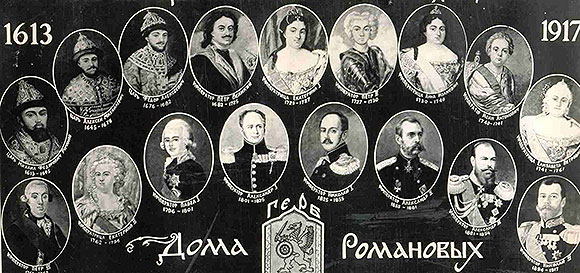February 21, 2013, marked the 400th anniversary of the House of Romanov. In honor of this date, Columbia University held a conference entitled “In Search of Empire,” which was co-sponsored by the Institute of Modern Russia.

Richard Wortman, the James Bryce Professor Emeritus who specializes in the history of imperial Russia, addressed the nature of Russian authority and dynastic succession, noting the considerable differences between the Russian experience and the experiences of other European states. According to Wortman, while laws played an important role in ensuring the stability and succession of monarchical power in Western Europe, in Russia, the “legal tradition of dynastic succession” was practically absent. Marina Soroka from Montreal’s McGill University spoke about Russia’s image in mass culture abroad, pointing out that in the majority of cases, the Romanovs’ efforts to “advertise” Russia were unsuccessful. The image of the state was largely associated with the personal image of the monarch, which was often seen through the lens of “despotic” stereotypes.
Tanya Chebotarev, curator of the Bakhmeteff Archive of Russian and East European History and Culture, hosted a brief exhibition tour. The exhibition displayed works from the collections of the Bakhmeteff archive and the Rare Book & Manuscript Library, including personal documents, letters, and photographs of members of the Romanov dynasty. Russian historian Vladimir Lapin discussed the importance of celebrating historic events during the Romanov dynasty, when “military jubilations” served as a symbol of “epochal” positive changes in Russian society. Even military defeats were presented as moral victories. The monarch was closely associated with the achievements and glory of the state. As Lapin pointed out, in military myths “monarchs held a more important place than the winners.”
While laws played an important role in ensuring the stability and succession of monarchical power in Western Europe, in Russia, the “legal tradition of dynastic succession” was practically absent.
Another topic for discussion was the personal protection of the Czar: two presenters discussed the role of renowned individuals who played an important role in protecting the Russian imperial family: Vladimir Dzhunkovsky and Alexander Spiridovich. Zinaida Peregudova, Senior Fellow at the State Archive of the Russian Federation, spoke about the safety of the emperor during foreign trips: according to her, while the domestic security system was quite effective since the 17th century, insufficient attention was given to protecting the emperor abroad. The situation changed after the attempt on Alexander II during his visit to France. A new secret service was tasked with ensuring the protection for the monarch outside Russia. Later, the so-called Foreign Secret Police was established with the aim of monitoring the activities of Russian revolutionaries abroad.

Left to right: Jane Burbank, Alexander Semyonov, Ilya Gerasimov, Sergey Glebov.
The panel entitled “Modern Challenges to Dynastic Empire: Post-Reform Russia and Visions of Modern Heterogeneous Space” presented a special interest for those who study imperial Russia. It featured a group of distinguished historians, including Sergey Glebov (Associate Professor at Amherst College); Marina Mogilner and Ilya Gerasimov (co-editors of the international scientific journal Ab Imperio, Kazan, Russia); and Alexander Semyonov, Dean of the History Department at the Higher School of Economics in St. Petersburg. This is the same group that is developing “The New Imperial History: IMR on Innovative Approaches to the History of Russia and the Post-Soviet Space,” a project sponsored by the Institute of Modern Russia.
In his presentation, Sergey Glebov focused on Siberian regionalism that existed in the Russian imperial period. Siberia only became part of the empire under Catherine the Great, and the process of “adaptation” in this region was similar to colonization. As Glebov pointed out, Siberian life, morals, and character differed from the European part of Russia, and, over time, indigenous people suffered the same fate as the colonized populations of America and Australia.
In the late 19th–early 20th century, the idea of empire was a part of Russian liberals’ public discourse.
As part of her research, Marina Mogilner compared the image of Russian poet Alexander Pushkin, who was a symbol of the “nation’s body and soul,” with the role of the Russian Czar. According to Mogilner, in the first half of the 19th century, Czar Nicholas I had gradually turned into a symbol of state power, while Pushkin embodied “the nation’s soul” and was recognized by many contemporaries as a poet of “international importance.” At the same time, Pushkin’s race (he was a descendent of Abram Gannibal, an Ethiopian brought to Russia as a gift for Peter the Great) remained an issue for nationalist researchers, such as Dmitry Anuchin and Ivan Sikorsky. While Anuchin doubted that Pushkin had African blood, Sikorsky acknowledged that fact, but tried to prove that, in Pushkin’s case, strong Slavic genes overwhelmingly conquered “the week Negroid blood.”
In his turn, Alexander Semyonov reflected on the “new liberalism” of the late 19th-early 20th century, noting that the idea of empire was a part of Russian liberals’ public discourse. For example, the Constitutional Democrats (Kadets) considered the ideas of “nationalism and dynastic regime” as the basic frame of discourse. One of the party’s founders, Pavel Milyukov, wrote that Russia must be a “constitutional and parliamentary monarchy,” even though this idea was rejected by the more revolutionary group within the liberal community. Among other ideas in the political discourse was the possibility of a “confessional state” being built into the “dynastic regime.”
Ilya Gerasimov emphasized that, even though the educated part of Russian society could communicate through the public discourse, other large segments of the population (including up to 50 percent of the urban residents on the Volga) were illiterate. Very few had access to the press. Russia’s urban population was quite heterogeneous: one in three town residents was a migrant and spoke a different language. As Gerasimov pointed out, this explains the fact that parts of society that had been excluded from any public discourse accepted Bolshevik and Stalinist discursive practices imposed on them after 1917.